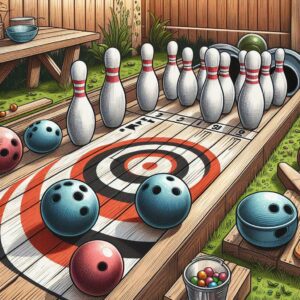Bowling is a popular sport that people of all ages can enjoy recreationally or competitively. When you head to the bowling alley, you’ll naturally want to knock down as many pins as possible and achieve a high score. But what actually constitutes a “good” bowling score?
The range of bowling scores considered solid or above average can vary quite a bit. Factors like your skill level, bowling format, goals, and conditions on the lane all impact how you define bowling success on a given day. With some practice and an understanding of bowling scores, you can set and achieve reasonable targets.
In this in-depth guide, we’ll explore common scoring levels for new, intermediate, and advanced bowlers. You’ll learn how strikes and spares dramatically increase your potential scores. We’ll also discuss equipment choices, oil patterns, consistency, and more to help you bowl to your abilities. Let’s get rolling!
Scoring Basics in Bowling
Before diving into specific scores, it helps to understand some scoring basics:
- Bowling uses 10 pins set up at the end of the lane. The goal is to knock down as many pins as possible per roll.
- A game is 10 frames, allowing for up to 12 rolls. Strike or spare in the 10th frame earns bonus rolls.
- When all pins are knocked down on the first roll, it’s a strike. When the remaining pins are cleared with the second roll, it’s a spare.
- Strikes earn 10 points plus the pins knocked down on the next two rolls. Spares earn 10 plus the next roll.
- Open frames with no strike or spare just earn the pin count of each roll.
- Scores are calculated by adding up points per frame. Higher scores come from more strikes and spares.
- Professional and league games are often played on sport-compliant oil patterns that influence ball motion.
Now that we’ve covered the basics, let’s look at typical bowling scores for players at all levels.
What is a Good Bowling Score for Beginners?
When you first pick up a bowling ball, you’ll be happy to knock down any pins at all. Don’t expect triple-digit scores right off the bat as a beginner. Focus first on developing proper bowling form and accuracy.
For complete newcomers, a “good” score might simply be toppling a few pins per frame and breaking 50-70 points in a game. Improvement will come quickly if you stick with it. Within a few games, reaching scores in the 100-120 range is a reasonable early goal.
Here are some bowling performance marks to strive for as a beginner:
- Break 100 points: This milestone’s first 100+ score feels great. Celebrate finally reaching triple digits.
- Bowl a spare: Knocking down those final pins on your second roll is thrilling. Spares boost your score.
- Roll multiple strikes: Strings of multiple strikes in a game provide a huge adrenaline rush.
- Exceed 120 points: Consistent 100+ games with some spares and the occasional strike.
- Beat your high score: Improving your personal best is extremely motivating as a new bowler.
The keys at this stage are making adjustments, developing consistency, and sparing when you can. Be patient and focus on fundamentals rather than high scores.
What’s the Average Bowling Score for Intermediate Bowlers?
After bowling regularly for a while and increasing your skills, you’ll naturally see your average scores climb higher. Intermediate bowlers who have moved beyond the beginner phase can expect to regularly score in the 120-150 range.
Joining a weekly league and practicing often will quickly elevate your game. You’ll learn how to adjust between lanes, make spares more consistently, and deal with tricky splits. Expected scores for intermediate bowlers are:
- 140-150 in open play: Bowling solid games regularly even without league oil patterns.
- 150-170 in league play: Typical house shot league average range to reach.
- 180 game: Occasionally topping 180 shows your skills are strengthening.
- 200 game: Breaking the elusive 200 mark proves you’re advancing.
- 550+ series: Total pinfall for a quality 3-game league series.
The difference between novice and intermediate is learning how to pick up spares, target specific bowling zones, and adjust equipment/speed for changing lane conditions. Keep working on your mechanics and spare shooting to reach the next level.
What Do Advanced Bowlers Score?
For seasoned bowlers who have mastered skills like spare conversion and adjusted release, scores of 180+ are definitely within reach. Scores above 220 are considered pro-level.
Here are exceptional scores that advanced bowlers pursue:
- 180-200 average: Expected average for top amateur league players.
- 200-220 games: Regularly topping 200 shows professional potential.
- 250+ games: Only elite players reach 250+ games. Requires many strikes.
- 800+ series: Stellar pro-level performance for a 3-game series.
- 300 game: The “perfect game” with 12 consecutive strikes is the holy grail.
The difference between good amateur and elite pro scoring comes down to unmatched consistency, pinpoint accuracy and nuanced adjustments. Physical fitness also ensures pros can maintain peak performance.
Top professionals like Jason Belmonte and Norm Duke make bowling look easy. But they’ve spent countless hours mastering their craft. With enough practice, advanced bowlers can realistically reach scores of 200+ as well.
How Strikes and Spares Drastically Increase Scores
Comparing open frames to strikes and spares reveals a huge scoring advantage. Knocking down every pin in one or two rolls per frame paces you for big scores.
Let’s break it down:
An open frame with rolls of 5 and 3 nets just 8 points. But a strike earns 10 plus your next two rolls. If you roll two more strikes, that one strike frame scores 30 points!
Likewise, a spare with 3 pins and then 7 pins on the second roll earns 13 points after the bonus. Double spares with two rolls earning 10 points per frame are better than open frames with low counts per roll.
Over a full game, several strikes and spares compound your score exponentially compared to all open frames. Strikes in particular set you up for the highest potential game scores. Focus on hitting pins solidly in the pocket to increase your chances of strike bowling.
Spares require precision, but any good bowling strategy emphasizes their importance too. You should be attempting to spare in every frame you don’t strike in. Maximizing pins on every frame through strikes or spares is the key to a big score.
How Equipment Choices Impact Bowling Scores
Your equipment choices make a difference in scoring consistency and potential. Having properly fitted gear tailored to your bowling style gives you the best chance to maximize pin count.
The right ball helps you reliably hit the pocket to achieve more strikes. Higher-end balls enhance power and pin action from pro-preferred core shapes and coverstock materials. Have a professional watch your bowl and recommend potential balls to match your release, speed, rev rate, and lane conditions.
Don’t overlook the importance of having your own custom-fitted bowling shoes. Rental shoes won’t provide the same traction and sliding motion of performance shoes tailored to your delivery. Good shoes enhance comfort, stability, and balance through your approach.
For other accessories like gloves, towels, wrist supports, or finger tape, test options out to see if they help you feel more confident and bowl better. It’s not necessary to buy everything on the market. Focus on equipment that feels right for your game.
Oil Patterns Change Everything in Bowling
Lane oil patterns dictate how a bowling ball moves. So the same bowler can score much differently on wet/dry or easy/tough patterns. This is why pros excel – they dissect oil and adjust.
House patterns in general provide some oil in the middle with drier outside boards. This gives you room for error. You’ll score best playing straighter lines until you’re forced wider.
Sports patterns challenge you to play aggressive lines and make quick adjustments as oil evaporates. Every board matters when mapping your angles. Staying in front of transitions separates good from great bowlers.
If you practice enough on various patterns, you’ll learn when and how to alter speed, location, and equipment to match changing lane conditions. Understanding oil is invaluable to lifting averages.
Focus on Consistency for Improving Bowling Scores
Bowling well isn’t about rolling huge scores one game and then struggling to break 100 the next. To regularly bowl high scores, focus on consistency in your performance.
Work on repeating shots with the same speed, release, and target at the arrows. If you throw a strike ball, lock it in muscle memory to repeat when needed. Eliminate variables in footwork, timing, shoulder alignment, and more.
Practice visual targeting to improve accuracy. Envision the exact pocket spot you want to hit on every shot. Hit your visual target and make adjustments as needed.
On spare attempts, find trigger points on the lane to stand and align your shoulders consistently. Shut out distractions and lock in on hitting your mark with the speed and revs to make spares.
Consistency also applies to mental preparedness, pre-shot routine, fitness, and oil reading skills. Mastering these factors will boost your scoring rates and help you reach the next level.
What’s the Ideal Scoring Pace for Quality Games?
Keeping a steady pace in your game helps avoid rushing and mentally checking out. Don’t sprint to finish a game quickly or throw balls haphazardly. But you also shouldn’t overthink and second-guess every shot. Find your rhythm.
Taking about 20 seconds per shot allows you to follow a mindful pre-shot routine:
- Breathe and visualize your target for 2-3 seconds
- Make any needed surface or feet adjustments for 5 seconds
- Four-step approach and delivery over 4-5 seconds
- Watch ball motion and pin action for 5+ seconds
- Reset for your next optimal shot
This steady 20-second pace per frame keeps you focused, without dragging slowly or rushing. You’ll make better shots when you shut out distractions and trust your instincts. Let muscle memory take over.
Of course, certain situations like stringing multiple strikes or facing big splits require additional time. But in general, keep a consistent smooth pace and rhythm. Don’t rush for the sake of speed.
Drills and Practice Tips for Improving Bowling Scores
Dedicated practice is the only way to keep strengthening your bowling skills and scoring ability. Even pro bowlers train for hours daily. Here are some of the best drills and tips:
- Practice games focusing only on spares – Improving spare percentage directly lifts scores.
- Repeat strike ball – Build muscle memory by throwing your best strike shot.
- Adjust speed – Try slower and faster rolls to expand your comfort zone.
- Play different lines – Don’t get stuck targeting just one zone.
- Train on sport patterns – Learn how oil breakdown impacts ball motion.
- Physical fitness – Strength, cardio, and stretching keep energy and consistency high.
- Frame-specific goals – Target strike or spare minimum per frame.
- Compete against self – Beat your average, high game, or high series.
- Get coaching – Work on improving mechanics and adjustments.
- Mental game – Visualize success. Learn relaxation and focus techniques.
- Analyze your game – Review stat trends to identify strengths/weaknesses.
Applying these targeted drills and training methods will build your bowling skills exponentially if done regularly. You can’t just show up and bowl well. Scoring takes dedicated practice.
Conclusion
A “good” bowling score means different things based on your skill level and goals. Beginners should celebrate new personal bests and milestones like breaking 100 points.
Intermediate bowlers can strive for 140-170 average scores in league play. Advanced players can reasonably target 180+ averages with their expertise.
Ultimately, focus on your own progress more than any specific score number. Each strike, spare, or new high game is an achievement to build confidence. Bowling consistently well takes patience, practice, and making smart adjustments.
With the right ball, well-fitted shoes, and an understanding of lane oil patterns, your scores will improve over time. Remember to keep a smooth pace and stay mentally focused through the highs and lows. Stick to your process and trust your abilities.
Next time you hit the lanes, apply these scoring insights to help elevate your bowling skills. You might just surprise yourself with a new personal best game. Let us know your biggest bowling accomplishments and highest scores in the comments below!
Frequently Asked Questions
How hard is it to bowl a 200?
Bowling a 200-game is quite challenging and requires advanced skills. Only around 5-10% of league bowlers average 200+ scores. Achieving a 200 game involves throwing mostly strikes and converting any spares. Accuracy, power, and proper adjustments are key to reaching this milestone. With practice, intermediate bowlers can eventually work up to break the 200 mark.
What is your score if you get all the spares?
If you throw a spare in every frame, including the 10th frame, your total score would be 190 points. This assumes you knock down all 10 pins over two rolls in each frame. Getting all spares shows excellent consistency, but to maximize scores it’s better to aim for strikes.
What is the average bowling score for a woman?
The average bowling score for female league bowlers ranges between 140-160 typically. Highly skilled female players can certainly exceed that into the 180+ range. Women also compete on pro tours and at the highest levels. But on average, female bowling scores are a bit lower than men mainly due to physiological factors like muscle mass and variations in technique.
How many 300 games are there in bowling?
Since the earliest recorded 300 games in 1900, there have been approximately 18,000 certified 300 games bowled through 2022. 300 games remain extremely rare feats, although the number has increased along with the popularity of bowling and greater training resources available. Less than 1 in 1 million games end in 12 consecutive strikes for a perfect 300 score.
How rare is it to bowl a 300?
Rolling a perfect 300 game is exceptionally rare. The odds have been estimated around 1 in 11,500 to 1 in 38,000 per game. To achieve a 300, a bowler must throw 12 straight strikes with no room for error. Considering over 100 million games are played annually in the US, only a tiny percentage end up being 300s. It takes immense skill and some luck to bowl a 300.
What are 5 strikes in a row called?
In bowling, throwing 5 consecutive strikes is called a five-bagger. Some other nicknames for this impressive feat are “five in a row” or a “turkey and a double”. Making 5 strikes demonstrates great consistency and puts you in position for a big scoring game.
What is 6 strikes in a row called?
When a bowler throws 6 back-to-back strikes, it’s referred to as a six-pack. Other slang terms for this accomplishment are “three doubles in a row” or “double turkey”. Only advanced players have the precision to regularly convert 6 strikes consecutively.
What is 8 strikes in a row called?
Stringing together 8 consecutive strikes is called an octo-strike or “octuple strike” in bowling lingo. It might also be called a “quadruple-double”, since that’s four double-strikes in a row. Eight perfect frames put you well on your way to a 300 game if you can finish it off.
How much is 5 strikes in a row?
In scoring, a five-bagger (5 strikes in a row) earns a total of 60 points if followed by two open frames of 5 pins each. The first strike is 30 points (10 plus the next two balls of 10 each). The subsequent 4 strikes are 20 points each (10 plus the next ball). So 5 strikes in a row scores a total of 60 points, assuming no additional strikes or spares.





